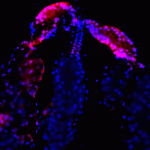Link to Pubmed [PMID] – 25122228
Proc. Biol. Sci. 2014 Oct;281(1792)
Interactions between pathogens and their insect vectors in nature are under the control of both genetic and non-genetic factors, yet most studies on mosquito vector competence for human pathogens are conducted in laboratory systems that do not consider genetic and/or environmental variability. Evaluating the risk of emergence of arthropod-borne viruses (arboviruses) of public health importance such as chikungunya virus (CHIKV) requires a more realistic appraisal of genetic and environmental contributions to vector competence. In particular, sources of variation do not necessarily act independently and may combine in the form of interactions. Here, we measured CHIKV transmission potential by the mosquito Aedes albopictus in all combinations of six worldwide vector populations, two virus strains and two ambient temperatures (20°C and 28°C). Overall, CHIKV transmission potential by Ae. albopictus strongly depended on the three-way combination of mosquito population, virus strain and temperature. Such genotype-by-genotype-by-environment (G × G × E) interactions question the relevance of vector competence studies conducted with a simpler set of conditions. Our results highlight the need to account for the complex interplay between vectors, pathogens and environmental factors to accurately assess the potential of vector-borne diseases to emerge.








